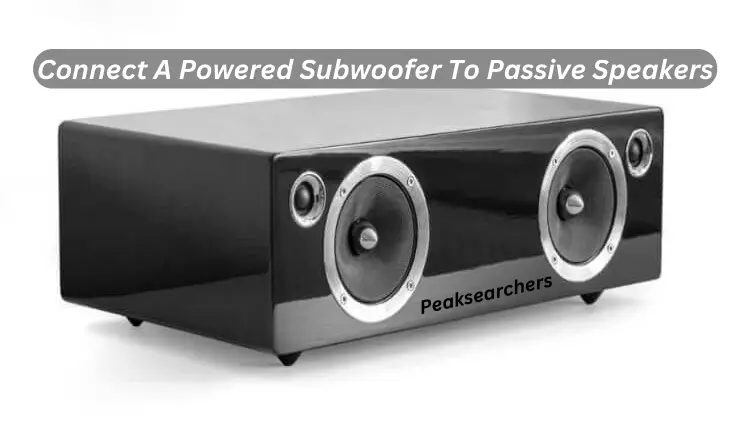How To Connect A Powered Subwoofer To Passive Speakers?
Welcome to our comprehensive guide on How To Connect A Powered Subwoofer To Passive Speakers. If you’re looking to enhance the low-frequency performance of your audio system, adding a subwoofer can make a significant difference.
In this article, we will provide you with detailed instructions and insights to help you successfully integrate a powered subwoofer into your setup, ensuring optimal sound quality and a seamless audio experience.

Understanding the Basics
Before we dive into the step-by-step process, let’s briefly discuss the fundamental concepts involved in connecting a powered subwoofer to passive speakers.
What is a Powered Subwoofer?
A powered subwoofer, also known as an active subwoofer, is a speaker system that includes its own built-in amplifier. This type of subwoofer is self-powered, meaning it doesn’t require an external amplifier to function. Powered subwoofers are designed to handle low-frequency audio signals and reproduce deep bass with precision and clarity.
Passive Speakers and Their Role
Passive speakers, in contrast, do not have an internal amplifier. They rely on an external amplifier or receiver to provide the necessary power to drive the speakers and produce sound. These speakers are responsible for reproducing midrange and high-frequency audio.
The Importance of Proper Integration
To achieve a balanced and immersive audio experience, it is crucial to integrate a powered subwoofer effectively with your passive speakers. This integration ensures that the subwoofer handles the low-frequency signals appropriately while the passive speakers handle the midrange and high-frequency signals, resulting in a cohesive and well-rounded sound output.
Step-by-Step Guide: Connecting a Powered Subwoofer to Passive Speakers
Follow the steps outlined below to connect your powered subwoofer to your passive speakers successfully:
1: Positioning and Placement
Begin by selecting an ideal location for your subwoofer and passive speakers. Consider factors such as room acoustics, available space, and the desired listening experience. Ideally, place the subwoofer near a wall or corner to maximize bass response.
2: Check the Connections
Ensure that your powered subwoofer and passive speakers are equipped with the necessary connectivity options. Most subwoofers and speakers utilize RCA or speaker wire connections. Verify that your equipment supports the same connection types to establish compatibility.
3: Connect the Subwoofer
- Locate the subwoofer’s line-level input, usually labeled as “Sub In” or “LFE In.”
- Connect one end of an RCA cable to the subwoofer’s line-level input.
- Connect the other end of the RCA cable to the subwoofer output or preamp output on your amplifier or receiver.
4: Connect the Passive Speakers
- Identify the speaker terminals on your amplifier or receiver, usually labeled as “Speaker Out.”
- Connect the positive (+) terminal of the left passive speaker to the positive (+) terminal on the amplifier/receiver using the speaker wire.
- Connect the negative (-) terminal of the left passive speaker to the negative (-) terminal on the amplifier/receiver.
- Repeat the process for the right passive speaker, ensuring proper polarity (+/-) connections.
5: Adjusting the Subwoofer Settings
Each subwoofer may have specific settings to optimize its performance. Consult the manufacturer’s manual for detailed instructions on adjusting the subwoofer’s crossover frequency, phase control, and volume level. Experiment with these settings to achieve the desired bass response and integration with your passive speakers.
Tips for Optimal Performance
To maximize the performance and enjoyment of your subwoofer and passive speaker setup, consider the following tips:
- Fine-tune the crossover frequency: Adjust the crossover frequency of your subwoofer to seamlessly blend the low-frequency output with the midrange and high-frequency output of your passive speakers.
- Experiment with phase control: Use the phase control settings on your subwoofer to ensure accurate synchronization of sound waves between the subwoofer and passive speakers.
- Room acoustics: Take into account the room’s acoustic properties, as they can affect the overall sound quality. Experiment with subwoofer placement to find the optimal position that minimizes room resonances and maximizes bass performance.
- Subwoofer isolation: To reduce unwanted vibrations and enhance bass clarity, consider using isolation pads or a dedicated subwoofer stand.
Also Read: How To Make All Speakers Work On Surround Sound?
FAQ’s
Can you connect speakers to a powered subwoofer?
Yes, you can connect speakers to a powered subwoofer. Powered subwoofers often have built-in amplifiers and speaker outputs for this purpose. To do this, check if your subwoofer has speaker-level inputs or outputs.
If your subwoofer has speaker-level inputs, connect your amplifier or receiver’s speaker outputs to these inputs using a speaker wire. If your subwoofer has speaker-level outputs, connect your main speakers to these outputs with a speaker wire. Ensure proper polarity when connecting the wires (+ to + and – to -).
After connecting the speakers, adjust the settings on your amplifier, receiver, and subwoofer to optimize the sound. This may involve configuring the crossover frequency, volume levels, and other settings.
By connecting speakers to a powered subwoofer, you can enhance the low-frequency performance of your audio system and create a more immersive sound experience.
How do you connect a powered subwoofer to powered speakers?
To connect a powered subwoofer to powered speakers, follow these steps:
- Check the available inputs and outputs on both the subwoofer and speakers, such as RCA, XLR, or 1/4″ jacks.
- Determine if the subwoofer has a dedicated subwoofer output or a full-range output.
- Identify the input options on the powered speakers.
- Connect the subwoofer output to the input on the powered speakers using an appropriate cable.
- Set the crossover frequency on the subwoofer to determine when it starts playing. A common starting point is around 80Hz.
- Adjust the volume levels on both the subwoofer and speakers for a balanced sound. Start with the subwoofer volume lower and gradually increase it.
- Fine-tune the settings, including the crossover frequency and volume levels, to achieve the optimal balance between the subwoofer and speakers.
By connecting a powered subwoofer to powered speakers, you can enhance the low-frequency performance and create a more immersive sound experience.
How to connect the passive subwoofer to the mixer?
Connecting a passive subwoofer to a mixer requires careful consideration of the available inputs and outputs. Here is a step-by-step guide to help you connect a passive subwoofer to a mixer:
- Identify the available outputs on the mixer: Check the mixer for dedicated subwoofer outputs or main outputs that can be used to connect the subwoofer.
- Determine the input options on the passive subwoofer: Passive subwoofers usually have speaker-level inputs, which are typically binding posts or Speakon connectors.
- Use appropriate cables: Depending on the connections available, use the appropriate cables to connect the mixer to the subwoofer. If the mixer has dedicated subwoofer outputs, you may need cables with XLR, 1/4″ TRS, or RCA connectors. If the mixer only has main outputs, you may need to use speaker wire with appropriate connectors.
- Connect the mixer to the subwoofer: If the mixer has dedicated subwoofer outputs, connect the appropriate cables from the mixer’s output to the subwoofer’s input. If the mixer only has main outputs, you will need to connect the speaker wire from the main outputs to the subwoofer’s speaker-level inputs.
- Ensure proper polarity: When connecting the speaker wire, make sure to maintain proper polarity, connecting the positive terminal (+) of the subwoofer to the positive terminal of the mixer and the negative terminal (-) to the negative terminal.
- Adjust settings: On the mixer, adjust the output level for the subwoofer channel to achieve the desired balance between the subwoofer and the other speakers connected to the mixer.
- Fine-tune the subwoofer: Adjust the settings on the subwoofer itself, such as volume, crossover frequency, and phase, to achieve optimal sound reproduction and integration with the other speakers.
By following these steps, you can successfully connect a passive subwoofer to a mixer and enhance the low-frequency performance of your audio system.
How to use passive to active subwoofer converter?
To connect a passive subwoofer to an active subwoofer output, you can use a passive-to-active subwoofer converter. Follow these steps:
- Obtain a passive-to-active subwoofer converter suitable for your setup.
- Identify the speaker-level inputs on the active subwoofer and the outputs on the passive subwoofer.
- Connect the passive subwoofer’s outputs to the converter’s inputs using a speaker wire, ensuring proper polarity.
- Use RCA cables or appropriate connectors to connect the converter’s line-level output to the active subwoofer’s line-level input.
- Adjust settings on the active subwoofer, such as volume and crossover frequency, to achieve the desired sound balance.
- Test the setup by playing audio to verify that the subwoofer receives the converted signal. Make adjustments as needed.
Using a passive-to-active subwoofer converter enables you to utilize a passive subwoofer with an active subwoofer output. This setup allows for enhanced low-frequency performance and integration with your audio system.
Also Read: How to Fix Blown Out Speakers? A Comprehensive Guide
Conclusion
Congratulations! You’ve now learned how to connect a powered subwoofer to passive speakers effectively. By following the step-by-step guide and implementing the tips provided, you can achieve a well-integrated audio system that delivers immersive and powerful sound reproduction.
Enjoy your enhanced audio experience and feel free to explore further optimizations based on your personal preferences and room characteristics.


